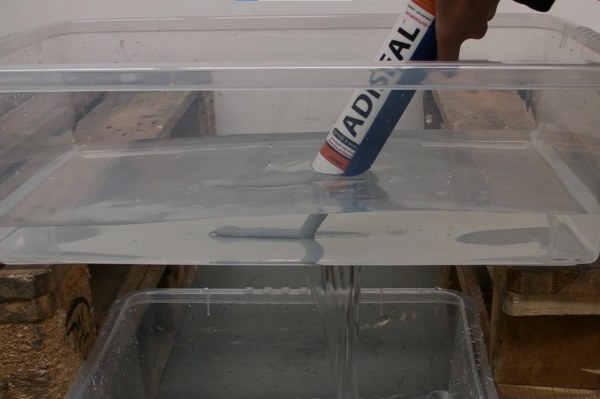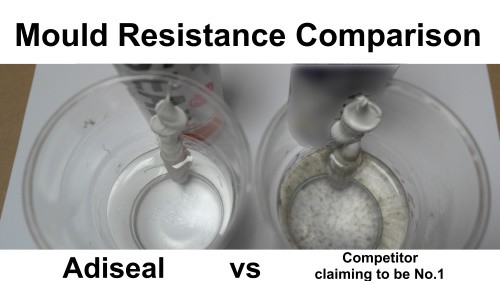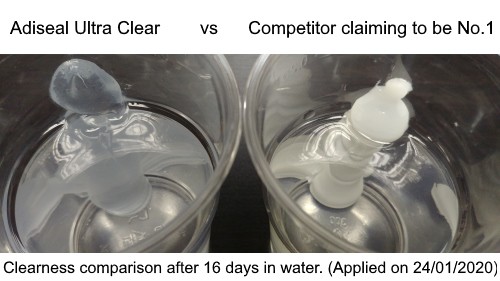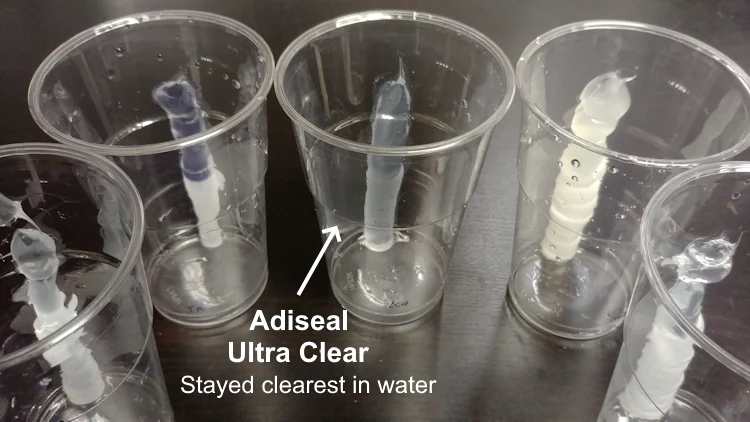Flexible Sealant
Flexible Sealant: Waterproof, Weatherproof & Versatile
Adiseal flexible sealant is a high performance and versatile sealant that provides a quality seal on many different applications. A sealant that is flexible is required when there could be movement in the joint. When there is movement in the joint, a non-flexible sealant will most likely crack or tear away from the substrate, damaging the seal. A flexible product will be able to maintain the seal without the movement breaking the seal. Adiseal has high flexibility and durability, providing a high quality waterproof seal that lasts a long time.

Why use a flexible sealant
It is common for movement in joints. This can be due to a number of reasons like:
- Temperature changes
- Air humidity changes
- External vibration
- Weight applied to substrate
- Wind
Temperature and moisture changes can cause expansion and contraction in the substrate. A non-flexible product which is brittle will start to break due to the movement. This can reduce the quality of the seal or even destroy it completely. There is also a chance of the non-flexible product tearing away from the substrate.
A sealant with high flexibility is designed to absorb all this movement without compromising the seal. It can also last a lot longer, reducing the need to remove the old sealant and re-apply new sealant.
Advantages of Adiseal
Adiseal has many advantages over other sealants, including:
- Works in dry, wet, even underwater
- Good initial grab (for even more grab, use Adiseal Hi-Grab)
- Gap filler adhesive
- Resists mould
- Over paintable (paint can be mixed into Adiseal Ultra Clear to make custom coloured sealant)
- Non brittle (stays flexible)
- UV resistant
- Waterproof adhesive
- Waterproof sealant
- Virtually odourless (no harsh solvent smell)
- Isocyanate free
- Solvent free (safe for use on sensitive materials)
- No shrinkage or cracking
- Flexible adhesive
- Strong sealant
- Prevent fungal growth
- Prevent bacteria growth
- Good resistance to chemicals
- EC1 Plus certified (No VOC)
- ISEGA certified – safe for use in food preparation areas
- Suitable for internal & external use
Mould resistant sealant test
At Adiseal Ltd, we are dedicated to providing the best flexible sealant which also requires a product with high mould resistance. In our mould resistance test, Adiseal outperformed all products tested, including a competitor claiming to be number 1 product, establishing its superior mould resistance. For detailed test results, please see the image below.

Mould resistance test result
Adiseal is the top choice for preventing mould growth, as seen in the image above. Despite extended water exposure, Adiseal remained entirely free of mould, while the competitor product showed signs of mould development. Adiseal’s outstanding properties offer enduring protection against mould growth, keeping your surfaces clean and pristine.
Flexible clear sealant
Adiseal Ultra Clear sealant & adhesive lives up to its name, ensuring clarity unlike other clear sealants that may appear cloudy or tinted when applied. Cheaper silicone sealants can compromise surface aesthetics with a cloudy or white appearance. However, with Adiseal Ultra Clear sealant & adhesive, your surfaces will maintain their clarity while benefiting from reliable clear waterproof protection. Adiseal’s crystal-clear formulation keeps your surfaces pristine and well-protected.
Adiseal Ultra Clear has strongest colour retention in water

Adiseal outperforms a competitor’s clear product in underwater colour retention. Unlike the competitor’s product, Adiseal remains crystal-clear when submerged, ensuring your surfaces maintain their aesthetics underwater. Rely on Adiseal’s to keep your surfaces looking their best in all conditions.
Clear sealant test in water
In the colour retention test of flexible clear sealants in water, we applied the products to new plastic cups. The cups were filled halfway with tap water, covered, and kept under identical conditions for several days. Adiseal demonstrated exceptional colour retention, preserving its clarity and transparency, while some competitor products exhibited signs of discolouration or cloudiness. Adiseal sealant excelled in maintaining its color, showcasing its effectiveness and durability even in challenging underwater conditions.

Adiseal top in colour retention test
Adiseal excelled in our tests, maintaining clarity both above and below the waterline, while competitor clear sealants turned white below the waterline. A competitor product claiming to be top-performing showed discoloration in both below and above the waterline, with their older formula outperforming their new one. Adiseal’s outstanding clarity retention ensures surfaces look their best, making it the superior choice for challenging weather conditions.
How to use a flexible sealant
Details of how to use a flexible sealant.
- Surface Preparation
Ensure the surfaces to be sealed are clean, dry, and free from dust, grease, or any other contaminants. Use appropriate cleaning agents if needed to achieve a clean surface.
- Cut the Nozzle
Cut the nozzle of the sealant tube to the required size of the bead.
- Apply the Sealant
Load the sealant tube into a caulking gun and apply a continuous bead of sealant along the joint or gap. Use steady pressure on the gun for a consistent application.
- Tooling
Use a caulking tool or your finger to smooth and shape the sealant for a neat and even finish. Remove excess sealant to create a tidy appearance.
- Curing Time
Allow the sealant to cure as per the manufacturer’s instructions. Keep in mind that curing time may vary based on temperature and humidity levels.
- Check for Proper Sealing
After curing, inspect the sealed area to ensure there are no gaps or voids, and the sealant adheres properly to the surfaces.
Tip: To store Adiseal once opened, leave about 1cm worth of product out of the nozzle and store the tube upright in a cool dry place. Adiseal requires moisture for it to cure. The exposed part out of the nozzle will cure creating a cap. To re-use Adiseal, pull the cured part out or cut the nozzle until the uncured part is reached.
What can you use flexible sealant on?
Adiseal is versatile product that such high performance that it usually outperforms dedicated sealants and adhesive. It serves as a reliable sealant for roofs, tiles, plastic, metal, doors, felt, and various other items. Adiseal can also effectively seal leaking gutters, even in rainy conditions, providing a robust and weather-resistant seal for multiple projects.
Where to buy?
In the UK, to buy flexible sealant from Adiseal stockists, contact us for details of your local stockist. For other countries, they can be purchased from online sellers like www.guglue.com who can ship worldwide.
We are looking for exclusive distributors for other countries. Please contact us for more details.
Painting over Adiseal sealant adhesive
Using water based paint over Adiseal sealant is possible but caution is advised. To ensure compatibility, perform a small test by applying the sealant on a disposable item, letting it cure, and then applying the paint. Observe whether the paint adheres or peels off. In general, most water based paints are compatible with Adiseal.
Colours
Adiseal adhesive and sealant is available in the following colours:
- White adhesive and white sealant
- Black adhesive and black sealant
- Grey adhesive and grey sealant
- Clear adhesive and clear sealant
- Brown adhesive and brown sealant
Adiseal can also be manufactured in any RAL colour.
Frequently asked questions about flexible sealant
When movement in joints happen, a non-flexible sealant can break or tear away from the substrate, reducing the quality or even breaking the seal. A flexible sealant will allow for this movement without reducing the quality of the seal. It can also last a lot longer, reducing the need to remove old sealant and re-seal.
Adiseal flexible sealant and adhesive does not shrink or crack. It does not contain solvents and remains flexible providing a durable seal and adhesive bond.
